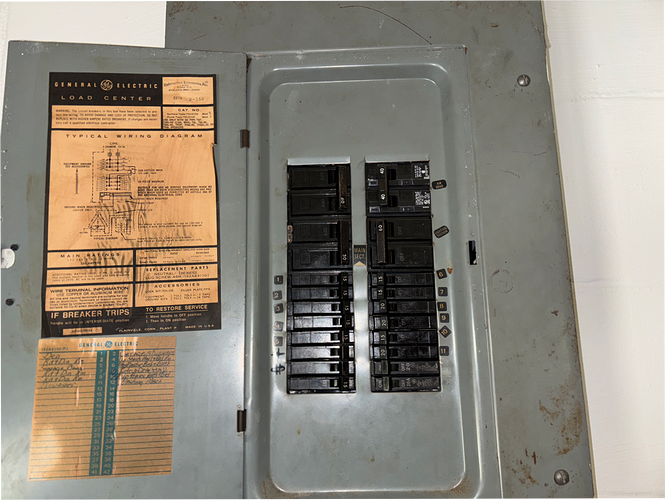Inspection today, 1978, 200 Amp, GE main panel in the basement. The ground bus bar is free-floating, but it’s connected to the neutral bus bar with a jumper. My initial inclination is that it’s correct, but, the bar needs to be secured. Am I way off base on this? Does it need to be secured/bonded to the panel?
Looks sloppy and yes the panel should be bonded to the grounds. Did you check for a bond? Wiggy leads between a hot terminal and the panel will verify a bond (it would be easier if there was a visible screw). Is the neutral bus bonded to the panel?
And…the neutral bus is connected to the panel with a strap and screw…so technically its all connected. Should the ground bus bar be secured…yes…but with the cover closed, whats really going to happen to the grounding bus bar? I can’t really think of anything right now.
As long as the enclosure is bonded somehow, and the loose bus is tied to the neutral bus, there isn’t a huge problem here. But, it would go in my report as a “sub-standard installation method.”
The additonal EGC bus is required to be connected directly to the enclosure due to the instructions included as part of its listing. It is bonded to the neutral via the bonding jumper so electrically it will work but the installation is not code compliant.
That’s no good. A serious potential electrical safety hazard, potentially leading to shocks, fires, or equipment damage.
ah, two roberts disagreeing with one another. one saying it will electricaly work while the other is saying it can lead to problems. which is it? are they both right? inquiring minds want to know. i do too.
Well, maybe you can Bob back and forth between the two.
It will work electrically, but as has been pointed out, technically it doesn’t meet code. One potential issue would be difficulty in removing or adding a conductor to the bus.
Surely Robert Young 15 year Certified Master Inspector isn’t making things up…again…right? ![]()
Exactly. Electrically the floating bus is nothing more than a big wirenut with a pigtail to the neutral bus which is permitted for EGC’s so there is no hazard as long as the pigtail is properly sized. The code violation issue with it laying in the panel is something else.
Certainly not a difficult decision as to who to trust with technical electrical data…
Robert Meier… ( New Jersey HHS Licensed Electrical Inspector, Licensed Electrical Sub-code Official, Licensed Electrical Contractor, Chief Moderator Emeritus Mike Holt Code Forum. Code references based on the 2020 NEC unless otherwise noted ).
i’m not getting into that…
![]()
How is it going to lead to shocks, fires, or equipment damage?
I was under the interpretation, grounding ensures electrical current faults are safely routed to the earth thus preventing electrical shocks and potential fires and that a loose or missing connection on the ground bus bar may/can disrupt this ‘safety path leading to dangerous situations.’
My thinking would evolve around, so what else is not connected properly in this obviously damaged, yes damaged, service panel.
Robert,
If you think about it the path for fault current is not to the earth. The earth is relatively poor conductor and is not permitted to be relied upon for clearing a fault therefore the earth connection of the system has no bearing on clearing a ground fault. A ground fault is cleared because the EGC is connected directly to the neutral via the MBJ (green screw) in the service panel.
Sorry. I will word it differently. Just woke up. Hard night. Arthritic pain.
Grounding serves as a low-resistance path for fault current to return to the source.
The service panel had the grounding buss disconnected. That is enough for me to consider other components might be disconnect. No more, No less.
Afternoon, George. Hope to find you well and in good spirits today.
To answer your question. My assumption was/is based on; grounding provides a safe path for fault currents to flow to the earth/ground thus preventing the build-up of electricity that could cause overheating, overloading, sparking, or electrocution. Am I wrong to assume this?
The first statement is correct but that path is not through the earth, it is accomplished by the connection to the system neutral. On your second point yes this panel shows obvious signs of poor installation practices which may indicate that there are other problems.
The neutral acts as a return path for electricity. !: Completing the circuit. 2: Carrying current back to the source.
I understand what the neutral path is routed in a service panel.
Ground buss bar serves as a central point for connecting all ground wires in the system.
Service panel and associated circuits at the the buss bar, are grounded/bonded by connecting a grounding wire, GEC to a grounding rod (or rods) driven into the earth outside the home or to the potable domestic water supply line, when conductive.
That ground bus is important when secured. When not secured it is a posable hazard.


